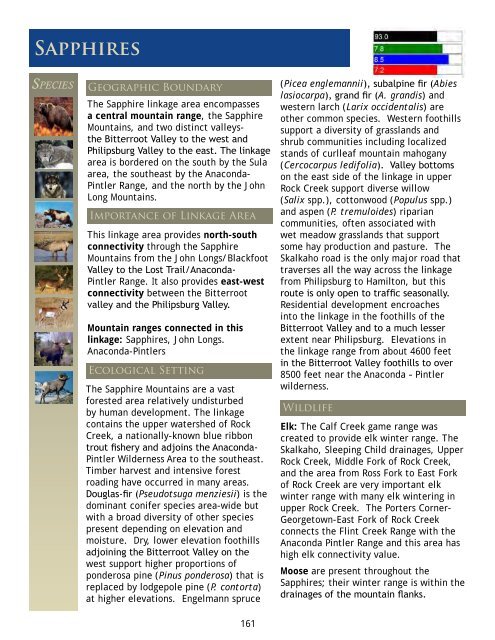The Hub Conservation Area - Montanans 4 Safe Wildlife Passage
The Hub Conservation Area - Montanans 4 Safe Wildlife Passage
The Hub Conservation Area - Montanans 4 Safe Wildlife Passage
Create successful ePaper yourself
Turn your PDF publications into a flip-book with our unique Google optimized e-Paper software.
SapphiresSpeciesGeographic Boundary<strong>The</strong> Sapphire linkage area encompassesa central mountain range, the SapphireMountains, and two distinct valleystheBitterroot Valley to the west andPhilipsburg Valley to the east. <strong>The</strong> linkagearea is bordered on the south by the Sulaarea, the southeast by the Anaconda-Pintler Range, and the north by the JohnLong Mountains.Importance of Linkage <strong>Area</strong>This linkage area provides north-southconnectivity through the SapphireMountains from the John Longs/BlackfootValley to the Lost Trail/Anaconda-Pintler Range. It also provides east-westconnectivity between the Bitterrootvalley and the Philipsburg Valley.Mountain ranges connected in thislinkage: Sapphires, John Longs.Anaconda-PintlersEcological Setting<strong>The</strong> Sapphire Mountains are a vastforested area relatively undisturbedby human development. <strong>The</strong> linkagecontains the upper watershed of RockCreek, a nationally-known blue ribbontrout fishery and adjoins the Anaconda-Pintler Wilderness <strong>Area</strong> to the southeast.Timber harvest and intensive forestroading have occurred in many areas.Douglas-fir (Pseudotsuga menziesii) is thedominant conifer species area-wide butwith a broad diversity of other speciespresent depending on elevation andmoisture. Dry, lower elevation foothillsadjoining the Bitterroot Valley on thewest support higher proportions ofponderosa pine (Pinus ponderosa) that isreplaced by lodgepole pine (P. contorta)at higher elevations. Engelmann spruce161(Picea englemannii), subalpine fir (Abieslasiocarpa), grand fir (A. grandis) andwestern larch (Larix occidentalis) areother common species. Western foothillssupport a diversity of grasslands andshrub communities including localizedstands of curlleaf mountain mahogany(Cercocarpus ledifolia). Valley bottomson the east side of the linkage in upperRock Creek support diverse willow(Salix spp.), cottonwood (Populus spp.)and aspen (P. tremuloides) ripariancommunities, often associated withwet meadow grasslands that supportsome hay production and pasture. <strong>The</strong>Skalkaho road is the only major road thattraverses all the way across the linkagefrom Philipsburg to Hamilton, but thisroute is only open to traffic seasonally.Residential development encroachesinto the linkage in the foothills of theBitterroot Valley and to a much lesserextent near Philipsburg. Elevations inthe linkage range from about 4600 feetin the Bitterroot Valley foothills to over8500 feet near the Anaconda – Pintlerwilderness.<strong>Wildlife</strong>Elk: <strong>The</strong> Calf Creek game range wascreated to provide elk winter range. <strong>The</strong>Skalkaho, Sleeping Child drainages, UpperRock Creek, Middle Fork of Rock Creek,and the area from Ross Fork to East Forkof Rock Creek are very important elkwinter range with many elk wintering inupper Rock Creek. <strong>The</strong> Porters Corner-Georgetown-East Fork of Rock Creekconnects the Flint Creek Range with theAnaconda Pintler Range and this area hashigh elk connectivity value.Moose are present throughout theSapphires; their winter range is within thedrainages of the mountain flanks.




